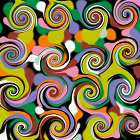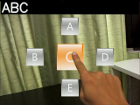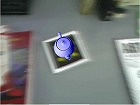(Collaboration with Keio University)
 |
|
In this research, we develop a technology called “computational ophthalmology” as an approach to dramatically improve the quality of social life of individuals with vision deficiency by making full use of the latest augmented reality technology. Various types of sensing devices are combined for capturing the objective configuration of a real environment scene or the subjective intentions of individual patient and we develop a method to compensate for the characteristic color perception and vision characteristic of the disease through an optical see-through / video see-through head-mounted display. |
 |
|
We invent artificial intelligence (AI) and augmented reality (AR) technology to support farmers to perform grape pruning efficiently. |
 |
|
This study proposes a novel affective image annotation technique, AffectI, for efficiently collecting diverse and reliable emotional labels with the estimate emotion distribution for images based on the concept of Game With a Purpose (GWAP). |
 |
|
Caricature: Example-based caricature synthesis techniques have been attracting large attentions for being able to generate attractive caricatures of various styles. This research proposes a new example-based caricature synthesis system using a feature deviation matching method as a cross-modal distance metric.
Portrait: Face image synthesis has potential applications in public safety. Drawing an image based on descriptions of what is in one’s mind is not an easy task for the majority of people. In this research, we propose a user-friendly system that can create a facial image from a corresponding image in the user’s mind. |
 |
|
Based on the mechanism of human visual attention, it is estimated how easily each pixel of an image can focus attention, and the quantitative representation is called a saliency map. The saliency map is used in image recognition, object detection, robot vision, advertisement design, etc., and is attracting attention in various fields. As a typical existing method, in the model of Itti et al., high saliency is assigned to the area which is largely different from the surrounding area by finding the peripheral difference of the visual feature quantity with multiple resolutions in color, brightness and direction. On the other hand, a structure in which a line converges to a certain point in an image as shown in the figure is called “leading line”, and it is known as a research result of cognitive psychology that a person’s gaze is drawn unconsciously to such a structure. In this study, we aim to predict human gaze more accurately by constructing a calculation model of saliency map prediction considering the guidance effect of gaze by leading line. |
Painterly Image Synthesis
 |
|
An artist usually does not draw all the areas in a picture homogeneously, but tries to make the work more expressive by emphasizing the focusing part while eliminating other irrelevant details. This paper presents a new technique for automatically converting an input image into a pencil drawing with the effect of emphasis and elimination. >> More |
 |
|
We present a new technique for artistic style transferring by considering the perceptual structure matching between the source image and the target images. Given a photograph, our technique first searches for an existing art work on a similar scene through using the computational model of GIST perception and then transfers both the color and brush texture from it by considering the structure matching between the two images. >> More |
 |
|
Automatic generation of film comic requires solving several challenging problems such as selecting important frames well conveying the whole story, trimming the frames to fit the shape of panels without corrupting the composition of original image and arranging visually pleasing speech balloons without hiding important objects in the panel. We propose a novel approach to the automatic generation of film comic. >> More |
Texture Synthesis
(Collaboration with Yamanashi Prefectural Industrial Support Center)
 |
|
With jacquard fabric, designers can create complex patterns by freely defining the over–under relationships between warp yarns and weft yarns at each grid point or intersections in the fabric. This study proposes a method for generating jacquard fabric patterns that reproduce the visual impressions of given input images and the electrical functions on jacquard fabric. |
Sample-based Tiling
(Collaboration with CAD/CG Laboratory Zhejiang University (China) and a Japanese Printing Company)
(Collaboration with CAD/CG Laboratory Zhejiang University (China) and a Japanese Printing Company)
 |
|
Marbling is an artistic printing technology that originated in Turkey and has been transmitted around the world from around the 14th century through Europe. The pigment is dropped into a highly viscous solution, stirred with a bamboo comb or the like to make a pattern, and transferred to paper or cloth. Stirring creates a flow in the solution, and the pigment is diffused and moved along the flow to form a pattern, so marbling can be regarded as a computational fluid dynamics problem. The developed system can generate the marbling pattern interactively while solving the Navir-Stoke equation and the advection-diffusion equation in real time by using the parallel processing function of graphics hardware. Also, by setting periodic boundary conditions in the solution, a pattern that can be seamlessly tiled is obtained and can be used directly for printing. |
3D Shape Reconstruction / Manipulation
 |
|
We propose a new natural click interface for AR systems. Through a study investigating how users intuitively click virtual objects in AR systems, we found that the speed and acceleration of fingertips provide cues for detecting click gestures. Based on our findings, we developed a new technique for recognizing natural click gestures with a single camera by focusing on temporal differentials between adjacent frames. We further validated the effectiveness of the recognition algorithm and the usability of our new interface through experiments. >> More |
 |
|
For confidentiality, it is usually not allowed to generate criminal CG video through subcontracting, whereas existing CG modeling and video editing systems are too complicated to use for police or prosecution. The proposed technique solves this problem with Augmented Reality (AR) technology. We propose to deploy multiple cameras and AR markers on criminal site. >> More |
 |
|
Planer markers enable an augmented reality (AR) system to estimate the position and posture of objects from images containing them. Conventional markers are difficult to be detected in blurred or defocused images. We propose a new marker that can be detected in such images. >> More |
Hairstyle Adviser
 |
|
Hairstyle is one of the most important features people use to characterize one’s appearance. This paper proposes a new technique for automatically retrieving a suitable hairstyle from a collection of hairstyle examples through learning the relationship between facial shapes and suitable hairstyles. |
 |
|
Conventional 2D image codes do not have semantics in images themselves. We propose a novel code, Be-code, for embedding data into a logo image. Be-code is generated from a logo image by modifying edge pixels according to the bits to be embedded, but avoiding causing obvious change to the appearance of the original logo image. >> More |
Visualization
Flow Visualization of Non-regular grid data with White Noise

















